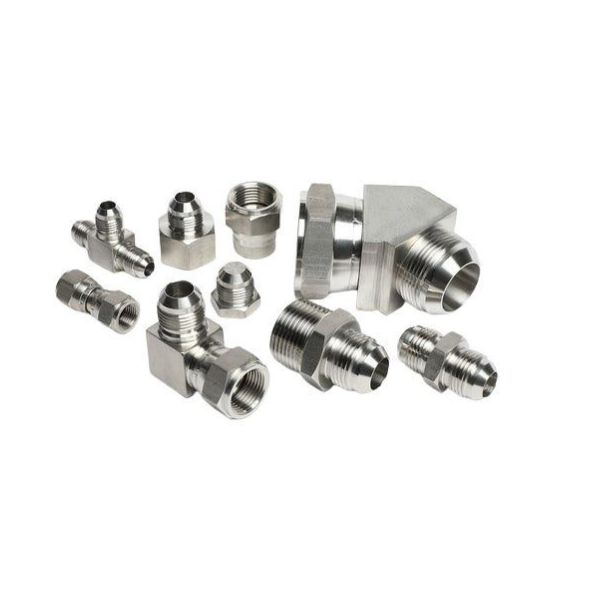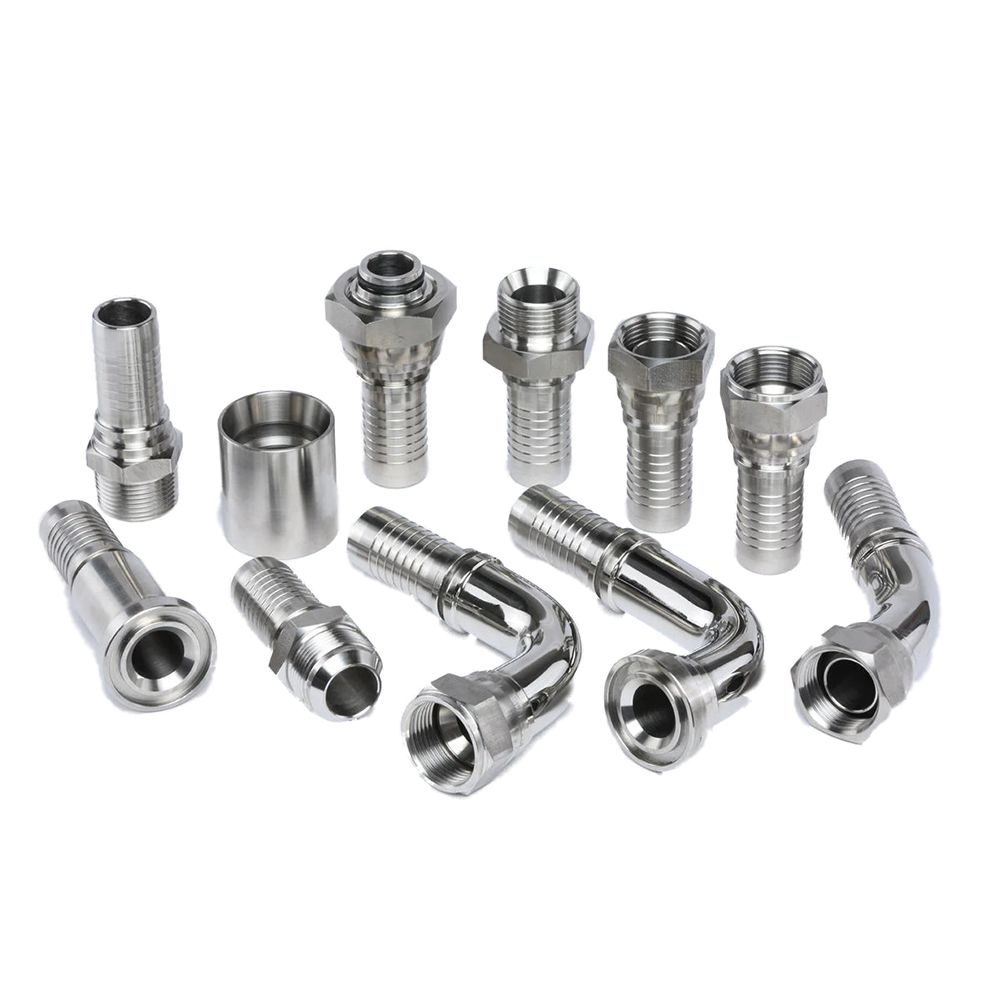Among the various materials used in hydraulic fittings, stainless steel stands out due to its exceptional properties. Known for its strength, corrosion resistance, and longevity, stainless steel is an ideal choice for hydraulic applications. This material’s ability to withstand extreme temperatures and resist harsh environmental conditions makes it highly suitable for demanding industries such as oil & gas, marine, and construction. Understanding the benefits of stainless steel hydraulic hose fittings is crucial for optimizing system performance, enhancing durability, and ensuring long-term reliability. By choosing stainless steel, industries can leverage these advantages to improve operational efficiency and reduce maintenance costs.
Features of Stainless Steel

Material Composition
Alloys
304 Stainless Steel: This is the most commonly used stainless steel alloy in hydraulic fittings. It offers good corrosion resistance and is suitable for a wide range of applications. However, its resistance to chlorides and other harsh chemicals is limited compared to alloy 316.
316 Stainless Steel: Known for its superior corrosion resistance, alloy 316 is often used in more demanding environments, such as marine applications or chemical processing. The addition of molybdenum enhances its resistance to chlorides and reduces the likelihood of pitting and crevice corrosion.
Properties
Chromium Content: Stainless steel contains a minimum of 10.5% chromium, which forms a passive layer of chromium oxide on the surface. This layer protects the underlying metal from oxidation and corrosion, contributing to the material’s overall durability.
Mechanical Properties
Strength
High Tensile Strength: Stainless steel is renowned for its impressive tensile strength, allowing it to withstand high-pressure conditions without deforming or failing. This characteristic is crucial for hydraulic fittings, which must maintain their structural integrity under significant pressure.
Temperature Resistance
Extreme Temperature Tolerance: Stainless steel can endure a wide range of temperatures, from cryogenic conditions to high heat. This makes it suitable for applications that experience extreme thermal variations. For instance, alloy 316 can handle temperatures up to 1600°F (871°C) in intermittent exposure, which exceeds the operational limits of most hydraulic hoses.
Corrosion Resistance
How It Works
Chromium Oxide Layer: The chromium in stainless steel reacts with oxygen in the air to form a thin, stable layer of chromium oxide on the surface. This passive layer acts as a barrier to moisture and corrosive agents, preventing rust and corrosion from penetrating the metal.
Comparative Analysis
Performance in Corrosive Environments: Unlike many other metals, which may corrode or degrade in the presence of moisture, chemicals, or salt, stainless steel maintains its integrity. It is particularly advantageous in environments where exposure to corrosive substances is frequent, such as in marine or chemical processing applications. This superior corrosion resistance ensures a longer service life and reduced need for maintenance compared to metals that are more susceptible to degradation.
Advantages of Stainless Steel Hose Fittings
Durability and Strength
Material Properties of Stainless Steel
304 Stainless Steel: Composed primarily of iron, chromium (18%), and nickel (8%), this alloy provides a good balance of strength and corrosion resistance, making it suitable for many general applications.
316 Stainless Steel: Contains additional molybdenum (2-3%) in its composition, enhancing its resistance to chlorides and acidic environments. This alloy is preferred for more corrosive conditions, such as marine or chemical processing applications.
Strength Characteristics
Tensile Strength: Stainless steel is known for its high tensile strength, which allows it to withstand significant mechanical stress without deformation. This makes it ideal for high-pressure hydraulic systems.
Yield Strength: Stainless steel also offers high yield strength, ensuring that the material does not permanently deform under stress, which is crucial for maintaining system integrity.
Temperature Resistance
Maximum Temperature Thresholds and Applications
304 Stainless Steel: Can handle temperatures up to 1,600°F (871°C) intermittently. Suitable for most standard applications but may not be sufficient for extreme high-temperature environments.
316 Stainless Steel: More suitable for continuous exposure to high temperatures, handling up to 1,650°F (899°C) intermittently. It is used in applications requiring higher thermal stability, such as high-temperature processing.
Comparison with Other Materials’ Temperature Resistance
Carbon Steel: Typically has lower temperature thresholds and can become brittle at high temperatures, making it less suitable for extreme thermal conditions compared to stainless steel.
Brass: Generally, brass fittings have a lower temperature tolerance and can degrade faster under high heat compared to stainless steel.
Impact on Different Industries
Case Studies
Oil & Gas: Stainless steel fittings withstand the high temperatures and pressures associated with oil extraction and processing.
Construction: Used in machinery and equipment that operate in varying temperature conditions.
Marine: Essential for shipbuilding and offshore platforms, where fittings must resist both high temperatures and corrosive seawater.
Corrosion Resistance

Understanding Corrosion Resistance
Why Stainless Steel Resists Corrosion Better Than Carbon Steel and Brass
Chromium Layer: The chromium content in stainless steel forms a passive oxide layer that protects the metal from rust and corrosion, unlike carbon steel which can corrode quickly without protective coatings.
Molybdenum: In alloy 316, molybdenum enhances resistance to chloride-induced pitting and crevice corrosion, offering superior performance compared to brass.
Types of Corrosion and How Stainless Steel Withstands Them
Pitting Corrosion: Stainless steel, especially alloy 316, resists localized pitting better than brass or carbon steel due to its chromium and molybdenum content.
Crevice Corrosion: The passive layer of stainless steel protects against crevice corrosion, which can affect materials like carbon steel and brass in confined spaces.
Applications in Harsh Environments
Specific Industries Where Corrosion Resistance is Critical
Marine: Stainless steel fittings are used in boat construction and offshore installations where exposure to saltwater is constant.
Chemical Processing: Fittings are used in environments with aggressive chemicals where other materials would quickly degrade.
Examples of Successful Applications and Case Studies
Chemical Plants: Stainless steel fittings ensure longevity and reliability in chemical handling processes.
Desalination Plants: Marine-grade stainless steel fittings resist the corrosive effects of seawater.
Reliability and Longevity
Pressure Ratings and Performance
Maximum pressure ratings for stainless steel fittings
Standard Ratings: Stainless steel fittings are often rated up to 10,000 psi, making them suitable for high-pressure hydraulic systems.
Comparison with Pressure Ratings of Other Materials
Brass: Typically rated lower, often up to 6,000 psi, which limits its use in higher-pressure applications.
Carbon Steel: Can match stainless steel’s ratings but lacks the corrosion resistance required for certain environments.
Longevity and Maintenance
Typical Lifespan of Stainless Steel Fittings
Service Life: Stainless steel fittings can last over 50 years under normal operating conditions, significantly longer than fittings made from brass or carbon steel.
Maintenance Requirements and Low-Maintenance Advantages
Maintenance: Requires minimal upkeep compared to coated or non-stainless steel fittings, which may need frequent inspections and recoating.
Low Maintenance Requirements
Maintenance Needs of Stainless Steel Fittings
Why Stainless Steel Fittings Are Considered Low Maintenance
No Coatings Required: Stainless steel’s natural corrosion resistance eliminates the need for additional protective coatings, reducing maintenance tasks.
Ease of Cleaning: Stainless steel fittings are easy to clean and maintain, especially in environments where hygiene is crucial.
Comparison with Coated and Non-Stainless Steel Fittings
Coated Fittings: Coatings can degrade over time and require periodic reapplication. Stainless steel, however, maintains its performance without additional coatings.
Non-stainless steel Fittings: Typically require more frequent maintenance and inspections due to their lower resistance to corrosion and wear.
Cost-Effectiveness
Long-Term Cost Savings Due to Low Maintenance
Reduced Downtime: Lower maintenance needs result in less system downtime, which contributes to cost savings in operational and repair expenses.
Extended Service Life: The long lifespan of stainless steel fittings translates to fewer replacements and lower overall costs over the lifecycle of the fittings.
Impact on System Downtime and Overall Efficiency
Enhanced Efficiency: Reliable and low-maintenance fittings contribute to uninterrupted system performance, improving overall operational efficiency and reducing the likelihood of costly system failures.
Stainless Steel vs. Brass Hose Fittings
Material Differences
Corrosion Resistance
Stainless Steel: Offers superior resistance to rust and corrosion due to its chromium content, which forms a protective oxide layer on the surface. This makes it highly effective in harsh environments, including marine, chemical, and industrial applications where exposure to corrosive substances is common.
Brass: While brass has some corrosion resistance, it is not as robust as stainless steel. Brass fittings can suffer from dezincification (a type of corrosion where zinc is leached out) and may degrade more quickly in environments with high humidity or exposure to corrosive chemicals.
Strength
Stainless Steel: Known for its high tensile strength and ability to withstand higher pressures, making it suitable for high-pressure hydraulic applications. The strength of stainless steel fittings makes them ideal for applications where durability under stress is critical.
Brass: Generally, brass fittings have lower tensile strength compared to stainless steel. This limitation can lead to failure under high-pressure conditions or in applications requiring significant mechanical strength.
Cost Considerations
Initial Cost
Brass: Typically has a lower initial cost compared to stainless steel. This makes brass fittings an attractive option for applications with budget constraints or where high durability is not a primary concern.
Stainless Steel: Has a higher upfront cost, reflecting its superior material properties. This higher cost can be a consideration for initial procurement but does not always reflect the total cost of ownership.
Lifecycle Cost
Stainless Steel: Although more expensive initially, stainless steel fittings provide better long-term value due to their durability and low maintenance requirements. They tend to last longer, reducing the frequency of replacements and maintenance costs over time.
Brass: The lower initial cost of brass fittings can be offset by higher lifecycle costs due to their susceptibility to corrosion and wear, leading to more frequent replacements and maintenance, which can increase overall expenses.
Performance in Various Conditions
Temperature and Pressure Tolerance
Stainless Steel: Outperforms brass in both extreme temperature and pressure conditions. Stainless steel fittings can handle high temperatures and pressures more effectively, making them suitable for demanding applications in industries like oil and gas, aerospace, and manufacturing.
Brass: Limited in its tolerance for extreme temperatures and pressures compared to stainless steel. Brass fittings are more likely to fail or degrade when exposed to high temperatures or pressures, which limits their suitability for high-stress applications.
Environmental Suitability
Stainless Steel: Highly suitable for corrosive and harsh environments due to its excellent resistance to rust and chemical degradation. This makes stainless steel the preferred choice for applications in marine, chemical processing, and other aggressive environments.
Brass: Less suited for corrosive environments where stainless steel would be more effective. Brass fittings are more likely to deteriorate in conditions where exposure to chemicals, salts, or moisture is prevalent.
Stainless Steel vs. Carbon Steel Hose Fittings


Material Properties
Corrosion Resistance
Stainless Steel: Known for its superior corrosion resistance, stainless steel contains chromium which forms a passive oxide layer that protects the metal from rust and degradation. This makes it highly effective in corrosive environments, including chemical, marine, and high-humidity applications.
Carbon Steel: Typically less resistant to corrosion than stainless steel. Carbon steel often requires additional protective coatings, such as galvanizing or painting, to prevent rust. Even with coatings, carbon steel is more susceptible to corrosion over time compared to stainless steel.
Strength and Durability
Stainless Steel: Offers exceptional strength and durability. Its composition allows it to withstand extreme temperatures and pressures while maintaining its integrity in harsh conditions. This makes stainless steel fittings ideal for demanding applications in various industries, including aerospace, automotive, and industrial sectors.
Carbon Steel: While carbon steel is strong and capable of handling substantial loads, it does not offer the same level of performance as stainless steel in terms of longevity and resistance to environmental factors. Carbon steel can be prone to wear and degradation, especially under severe conditions.
Maintenance and Longevity
Maintenance Needs
Stainless Steel: Requires minimal maintenance due to its inherent corrosion resistance. Unlike carbon steel, stainless steel fittings do not need regular recoating or protective treatments. This translates to reduced maintenance efforts and costs over the lifespan of the fittings.
Carbon Steel: Requires regular maintenance to prevent rust and corrosion. This often includes periodic recoating or painting, which adds to the operational costs and effort required to keep the fittings in good condition. Regular inspections and maintenance are necessary to extend the life of carbon steel fittings.
Service Life
Stainless Steel: Generally has a much longer service life due to its resistance to degradation and minimal maintenance requirements. Stainless steel fittings can last several decades, even in harsh environments, making them a cost-effective choice in the long run despite a higher initial cost.
Carbon Steel: Typically has a shorter service life compared to stainless steel, especially in corrosive environments. The need for regular maintenance and the effects of corrosion can reduce the lifespan of carbon steel fittings, making them less durable over time.
Conclusion
The use of stainless steel fittings can significantly improve system reliability and operational efficiency. Their robustness and longevity reduce the frequency of replacements and maintenance, leading to lower operational costs and minimized downtime. For hydraulic systems that operate under critical and challenging conditions, stainless steel fittings are highly recommended. Investing in stainless steel fittings is a strategic choice for maintaining the integrity and performance of hydraulic systems, particularly in high-stress and harsh environments.
FAQ
What are stainless steel hydraulic hose fittings?
Stainless steel hydraulic hose fittings are connectors made from stainless steel that join hydraulic hoses to other components in a hydraulic system. They are known for their durability, strength, and resistance to corrosion.
Why should I choose stainless steel over other materials?
Stainless steel offers superior corrosion resistance, strength, and durability compared to materials like brass and carbon steel. It performs well under high pressure and temperature conditions and requires less maintenance.
What industries benefit from using stainless steel fittings?
Industries such as oil & gas, marine, construction, and aerospace benefit from stainless steel fittings due to their high performance in harsh environments and demanding applications.
How long do stainless steel hydraulic fittings typically last?
Stainless steel fittings are designed to last for several decades, depending on the application and maintenance. They are known for their long service life and resistance to wear and tear.
Are stainless steel fittings more expensive than other types?
Yes, stainless steel fittings generally have a higher initial cost compared to materials like brass or carbon steel. However, their durability and low maintenance needs can make them more cost-effective in the long run.
Do stainless steel fittings require special maintenance?
Stainless steel fittings require minimal maintenance due to their corrosion-resistant properties. They do not need additional coatings or frequent upkeep, which helps reduce overall maintenance costs.





